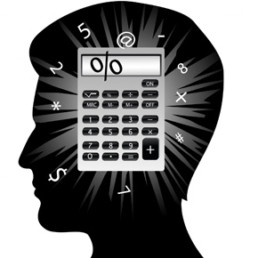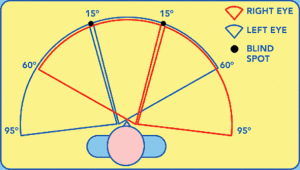This question came across a parent education and support forum on Facebook (Vision Therapy Parents Unite).
Eye movement skills have a lot of complicated underlying neurology. This blog post was written to offer patients some explanations for oculomotor dysfunction or deficits in saccadic eye movements in layperson terms.
Saccades, or saccadic eye movements, are high-speed “eye-jumps.”
The purpose of a saccadic eye movement is to place a peripheral target at the center of vision. (That is, the eye moves to shift an image which falls on the peripheral retina onto the fovea (center of vision).)
It can be executed voluntarily or involuntarily.
How does my eye decide how big of a jump to make?
 The brain estimates the distance between the peripheral target and the center of vision, and calculates how strong of a nerve impulse each of the involved eye muscles needs to receive in order to land precisely on-target. (Wow!)
The brain estimates the distance between the peripheral target and the center of vision, and calculates how strong of a nerve impulse each of the involved eye muscles needs to receive in order to land precisely on-target. (Wow!)
A saccade can be accurate, or you may observe an error in planning:
- If the eye undershoots the target, a second or third additional saccade may be needed to land as intended.
- If the eye overshoots the target, you may observe the eye pass the target and then back-track in a second step.
Another likely problem is difficulty with fixation, holding the eye steadily on a target. Many people with poor saccades may also have difficulty maintaining steady fixation away from “primary gaze” (straight-ahead). They often fail to sustain gaze off-center, bringing their eyes back to midline, or turning the head after moving the eye(s) so that the eyes re-center in their orbits (“eye-sockets”).
With developmental issues, there may also be a tendency to pause at midline when executing a saccade from one side of the body to the other.

This figure shows the relationship between saccade peak velocity and magnitude (amplitude) – From Bahill, Clark, Stark, (1975)
How fast is a saccade?
It typically takes about 200 ms (milliseconds) or 1/5 of a second to initiate a saccade.
The saccade itself is usually executed in about 20-30 ms.
The speed of the eye is measured in angular velocity, or degrees-per-second. The larger the saccadic distance (in degrees), the faster the eye will move during that saccade. Studies have found that the speed of the human eye tends to plateau at about 900º per second. (There are 90º in a right angle; so 900º per second means the eye would be able to travel a 90º right angle in a tenth of a second.)
Typically, a saccade of 10º amplitude is about 300º per second.
Typically, a saccade of 30º amplitude is about 500º per second.
If the eye movements are high-speed, how come I don’t see streaks across my vision when I look from place to place?
During a saccade, the brain places a temporary suppression on data coming from the eyes, so that we never see blurry or streaky vision while the eyes are moving at high speed. This suppression period begins just before the eye moves, and ends just after the eye reaches its target. (However, after a brain injury, it is possible for this safety mechanism to be disrupted, and for symptoms of visual streaking to occur.)
Typically, in children, poor saccadic eye movements are the result of:
- insufficient/ inaccurate use of peripheral vision
- unsteady fixations
- poor eye-teaming skills, resulting in asymmetric horizontal eye movements (these are particularly problematic when reading!)
- insufficient development of rhythm/ timing
Saccadic eye movement skills can be readily trained with optometric vision therapy, with practice of saccades in different directions, organized patterns, and with varied magnitudes. Working with the metronome is an important aspect for the rhythm/ timing challenges.
Visual perceptual skills should be trained in concert with saccadic eye movements, to help patients learn to integrate their improving visual skills into real-world situations. This includes attention to visual planning, visual-spatial awareness, visual motor integration, and visual spatial memory. Each of these areas helps to prime the use of peripheral vision, which is critical for saccadic eye movement skills.
“Fight or Flight,” Tunnel-vision, and Saccades
 A common problem is the presence of “tunnel-vision” as a consequence of the “fight or flight” response when a person is experiencing visual stress. This is often exacerbated at near-point for children who are struggling with reading skills (whether this is related to decoding problems or to eye-teaming and focusing problems).
A common problem is the presence of “tunnel-vision” as a consequence of the “fight or flight” response when a person is experiencing visual stress. This is often exacerbated at near-point for children who are struggling with reading skills (whether this is related to decoding problems or to eye-teaming and focusing problems).
As a result, the use of the peripheral vision decreases, and the child has trouble taking in more than a few letters at a time. This slows reading speed and impairs visual recognition skills; comprehension suffers as a result.
In cases like these, adjunctive therapies which help to bring the autonomic nervous system (sympathetic/parasympathetic nervous system) back to balance may also (indirectly) support deficits in saccadic eye movements.
Therapeutic supports include:
- Syntonic Phototherapy (Color therapy)
- Primitive Reflex retraining
- Some developmental/ behavioral optometrists evaluate the primitive reflexes necessary for vision development
- Some Physical Therapists take a brain-based approached to child development, supporting these skills as well
- Craniosacral Therapy
- Pediatric chiropractic therapy
I hope this page is a useful, parent-friendly resource. Please post additional questions below for further clarification.






Thank you for this blog post Dr. Slotnick! “Eye tracking problems” can be a very general term for many different visual problems. I appreciate how you specifically explained saccades. These eye movements are so important for reading and the ability to look quickly and accurately between objects. I appreciate you noting how saccadic eye movements differ from other tracking problems like fixation stability (having to break eye contact, side gazing), pursuit eye movements (poor ability to follow a moving target in different directions) and even convergence (watching from far-to-near). I look forward to reading more of your archived information as well.
Thank you, Dr. Simonson, for your thoughtful comments, along with the positive feedback.
Yes, the neurology and purpose of the other eye movements are worthy of separate exploration.
I hope you enjoy some of the archived materials!